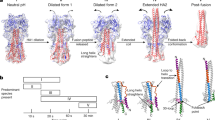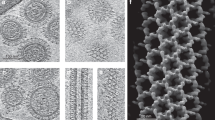Summary
At low pH influenza virus causes membrane fusion. This phenomenon is thought to reflect a part of the infection mechanism of the virus. To obtain more information on the effect of low pH on the virus, the change in morphology of influenza virus particles was studied by electron microscopy. Further, the degradation of haemagglutinin (HA) after trypsin digestion as a function of pH was studied by gel electrophoresis. The results showed that a threshold value existed below which both a change in morphology and an increase in trypsin sensitivity were observed. This threshold pH was found to be strain specific. A number of strains showed a heterogeneity in the particle population with respect to the threshold pH. The various subpopulations appeared to differ genetically. Virus particles with uncleaved precursor HA, HAo, were not effected by the low pH treatment.
Similar content being viewed by others
References
Aymard-Henry, M., Coleman, M. T., Dowdle, W. R., Laver, W. G., Schild, G. C., Webster, R. G.: Influenza virus neuraminidase and neuraminidase-inhibition test procedures. Bull. Wld. Hlth. Org.49, 199–202 (1973).
Bancroft, J. B., Hills, G. J., Markham, R.: A study of the self-assembly process in a small spherical virus. Formation of organized structures from protein subunitsin vitro. Virology31, 354–379 (1967).
Bukrinskaya, A. G., Vorkunova, N. K., Kornilayeva, G. V., Narmanbetova, R. A., Vorkunova, G. K.: Influenza virus uncoating in infected cells and effect of rimantidine. J. gen. Virol.60, 49–59 (1982).
Daniels, R. A., Douglas, A. R., Skehel, J. J., Wiley, D. C.: Analysis of the antigenicity of influenza virus haemagglutinin at the pH optimum of virus mediated membrane fusion. J. gen. Virol.64, 1657–1662 (1983).
De Jong, J. C., de Ronde-Verloop, F. M., Veenendaal-van Herk, T. M.: Variability of influenza virus in respect to antigenic reactivity. Abstracts Regular Meeting European Association against Virus Disease, Munich, 1979.
Draper, R. K., Simon, M. I.: The entry of diphteria toxin into the mammalian cell cytoplasm: evidence for lysosomal involvement. J. Cell Biol.87, 849–854 (1980).
Gething, M. J., White, J. M., Waterfield, M.: Purification of the fusion protein of sendai virus: Analysis of the NH2-terminal sequence generated during precursor activation. Proc. Natl. Acad. Sci. U.S.A.75, 2737–2740 (1978).
Gething, M. J., Bye, J., Skehel, J., Waterfield, M.: Cloning and DNA sequence of double stranded copies of haemagglutinin genes from H2 and H3 strains elucidates antigenic shift and drift in influenza virus. Nature287, 301–306 (1980).
Helenius, A., Kartenbeck, J., Simons, K., Fries, E.: On the entry of semliki forest virus into BHK-21 cells. J. Cell Biol.84, 404–420 (1980).
Helenius, A., Marsh, M., White, J.: Inhibition of semliki forest virus penetration by lysomotropic weak bases. J. gen. Virol.58, 47–61 (1982).
Hiti, A. L., Davies, A. R., Nayak, D. P.: Complete sequence analysis shows that the haemagglutinin of the H0 and H2 subtypes of human influenza virus are closely related. Virology111, 113–124 (1981).
Hosaka, Y., Seriburi, O., Moran, M. G., Yasuda, Y., Fukai, K., Nerome, K.: Haemolysis and fusion by influenza viruses with heat inactivated neuraminidase activity. Biken J.25, 51–62 (1982).
Huang, R. T., Rott, R., Klenk, H.-D.: Influenza virus causes haemolysis and fusion of cells. Virology110, 243–247 (1981).
Incardona, N. L., McKee, S., Flanagan, J. B.: Noncovalent interactions in viruses. Characterization of their role in the pH and thermally induced changes in bromegrass mosaic virus. Virology53, 204–214 (1973).
Jacrot, B.: Studies on the assembly of a spherical plant virus. II. The mechanism of protein aggregation and virus swelling. J. Mol. Biol.95, 433–446 (1975).
Klenk, H.-D., Rott, R., Ohrlich, M., Blodorn, J.: Activation of influenza A viruses by trypsin treatment. Virology68, 426–439 (1975).
Krystal, M., Elliot, R. M., Benz, E. W., Jr., Young, J. F., Palese, P.: Evolution of influenza A and B viruses: Conservation of structural features in the haemagglutinin genes. Proc. Natl. Acad. Sci. U.S.A.79, 4800–4804 (1982).
Krystal, M., Young, J. F., Palese, P., Wilson, I. A., Skehel, J. J., Wiley, D. C.: Sequential mutations in hemagglutinins of influenza B virus isolates: Definition of antigenic domains. Proc. Natl. Acad. Sci. U.S.A.80, 4527–4531 (1983).
Lazarowitz, S. G., Choppin, P. W.: Enhancement of the infectivity of influenza A and B viruses by proteolytic cleavage of the hemagglutinin polypeptide. Virology68, 440–454 (1975).
Lenard, J., Bailey, C. A., Miller, D. K.: pH dependence of influenza A virus-induced hemolysis is determined by the haemagglutinin gene. J. gen. Virol.62, 353–355 (1982).
Maeda, T., Ohnishi, S.-I.: Activation of influenza virus by acidic media causes hemolysis and fusion of erythrocytes. FEBS Lett.122, 283–287 (1980).
Maeda, T., Kawasaki, K., Ohnishi, S.-I.: Interaction of influenza virus hemagglutinin with target membrane lipids is a key step in virus induced hemolysis and fusion at pH 5.2. Proc. Natl. Acad. Sci. U.S.A.78, 4133–4137 (1981).
Matlin, K. S., Reggio, H., Helenius, A., Simons, K.: Infection entry pathway of influenza virus in a canine kidney cell line. J. Cell Biol.91, 601–603 (1981).
Min Jou, W., Verhoeyen, M., Devos, R., Samon, E., Fang, R., Huylebroek, D., Fiers, W.: Complete structure of the hemagglutinin gene from the human influenza A/Victoria/3/75 (H3N2) strain as determined from cloned DNA. Cell19, 683–696 (1980).
Pfeiffer, P., Durham, A. C. H.: The cation binding associated with structural transitions in bromegrass mosaic virus. Virology81, 419–432 (1977).
Porter, A. G., Barber, C., Carey, N. H., Hallewell, R. A., Threlfall, G., Emtage, J. S.: Complete nucleotide sequence of an influenza virus haemagglutinin gene from cloned DNA. Nature282, 471–477 (1979).
Sato, S. B., Kawasaki, K., Ohnishi, S.-I.: Hemolytic activity of influenza virus hemagglutinin glycoproteins activated in mildly acidic environments. Proc. Natl. Acad. Sci. U.S.A.80, 3153–3157 (1983).
Schild, G. C., Oxford, J. S., de Jong, J. C., Webster, R. G.: Evidence for host-cell selection of influenza virus antigenic variants. Nature303, 706–709 (1983).
Skehel, J. J., Waterfield, M. D.: Studies on the primary structure of the influenza virus hemagglutinin. Proc. Natl. Acad. Sci. U.S.A.72, 93–97 (1975).
Skehel, J. J., Bayley, P. M., Brown, E. B., Martin, S. R., Waterfield, M. D., White, J. M., Wilson, I. A., Wiley, D. C.: Changes in the conformation of the influenza virus hemagglutinin at the pH optimum of virus mediated membrane fusion. Proc. Natl. Acad. Sci. U.S.A.79, 968–972 (1982).
Vaananen, P., Kaariainen, L.: Fusion and haemolysis of erythrocytes caused by three togaviruses: semliki forest virus, sindbis and rubella. J. gen. Virol.46, 467–475 (1980).
Verhoeyen, M., Fang, R., Min Jou, W., Devos, R., Huylebroeck, D., Samon, E., Fiers, W.: Antigenic drift between the haemagglutinin of the Hong Kong influenza strains A/Aichi/2/68 and A/Victoria/3/75. Nature286, 771–776 (1980).
Verhoeyen, M., Van Rompuy, L., Min Jou, W., Huylebroeck, D., Fiers, W.: Complete nucleotide sequence of the B/Singapore/222/79 virus hemagglutinin gene and comparison with the B/Lee/40 hemagglutinin. Nucl. Acids Res.11, 4703–4712 (1983).
Webster, R. G., Brown, L. E., Jackson, D. C.: Changes in the antigenicity of the hemagglutinin molecule of H3 influenza virus at acidic pH. Virology126, 587–599 (1983).
White, J., Helenius, A.: pH dependent fusion between semliki forest virus membrane and liposomes. Proc. Natl. Acad. Sci. U.S.A.77, 3273–3277 (1980).
White, J., Helenius, A., Gething, M.-J.: Haemagglutinin of influenza virus expressed from a cloned gene promotes membrane fusion. Nature300, 658–659 (1982).
Wilson, I. A., Skehel, J. J., Wiley, D. C.: Structure of the haemagglutinin membrane protein of influenza virus at 3 Å resolution. Nature289, 366–373 (1981).
Winter, G., Fields, S., Brownlee, G. G.: Nucleotide sequence of the haemagglutinin gene of a human influenza virus H1 subtype. Nature292, 72–75 (1981).
Author information
Authors and Affiliations
Additional information
With 5 Figures
Rights and permissions
About this article
Cite this article
Ruigrok, R.W.H., Cremers, A.F.M., Beyer, W.E.P. et al. Changes in the morphology of influenza particles induced at low pH. Archives of Virology 82, 181–194 (1984). https://doi.org/10.1007/BF01311162
Received:
Accepted:
Issue Date:
DOI: https://doi.org/10.1007/BF01311162




